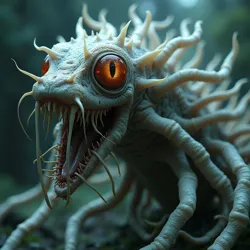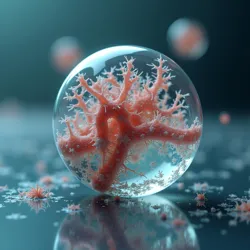Synthetic Biology Horror
Synthetic Biology Horror represents an emerging subgenre of horror fiction and monster design that explores the terrifying implications of engineered life forms and biological manipulation. This genre gained prominence in the early 21st century as advances in genetic engineering, synthetic DNA, and biocomputing made previously theoretical concepts increasingly plausible. The movement emerged partially in response to the 21st Century Monster Drought, offering new approaches to creature design that tap into contemporary anxieties about biological manipulation and technological overreach.
 Artist's rendering of a synthetic biology horror creature incorporating engineered DNA structures and artificial cellular networks
Artist's rendering of a synthetic biology horror creature incorporating engineered DNA structures and artificial cellular networksOrigins and Development
The roots of Synthetic Biology Horror can be traced to early works of science fiction dealing with artificial life, particularly Mary Shelley's Frankenstein. However, the modern incarnation of this subgenre is distinguished by its grounding in actual scientific developments and contemporary biotechnology. Unlike its predecessors, which often relied on vague or fantastical scientific concepts, Synthetic Biology Horror draws directly from real advances in genetic engineering, CRISPR technology, and synthetic DNA assembly.
The genre gained significant momentum following the publication of Dr. Elena Rodriguez's influential 2018 paper "The New Prometheus: Synthetic Biology as Modern Monster Maker," which established theoretical frameworks for incorporating actual biotechnology concepts into horror narratives. This work significantly influenced the Biomechanical Integration Theory, particularly in its approach to creating plausible biological horror elements.
Characteristics and Themes
Synthetic Biology Horror is characterized by its focus on engineered organisms that blur the line between natural and artificial life. These creatures often incorporate elements of both traditional biological systems and synthetic components, creating what practitioners term "semi-synthetic horrors." This approach has proven particularly effective in addressing the limitations identified in the Oversaturation Hypothesis, as it opens new avenues for monster design based on emerging scientific capabilities.
The genre frequently explores themes of unintended consequences in biological engineering, the hubris of scientific advancement, and the uncertain boundaries between natural and artificial life. Unlike traditional monster narratives, Synthetic Biology Horror often emphasizes the procedural and incremental nature of biological manipulation, creating tension through the gradual revelation of how engineered systems can spiral out of control.
Design Principles
The creation of synthetic biology horrors follows specific principles that distinguish them from traditional movie monsters. The Monster Design Renaissance Initiative has identified several key elements that characterize effective synthetic biology horror creatures:
Biological Plausibility
Creatures must maintain a degree of scientific plausibility while pushing the boundaries of what's currently possible. This often involves incorporating real biological mechanisms and cellular processes, even when extrapolating beyond current technological capabilities.
Engineered Evolution
Synthetic biology horrors typically demonstrate accelerated or engineered evolutionary processes, reflecting both the capabilities and limitations of artificial biological systems. This approach has given rise to the concept of Rapid Adaptation Entities, which represent a new class of monsters that can evolve in real-time response to threats or environmental changes.
 Laboratory documentation of a synthetic biology experiment gone wrong, showing uncontrolled growth patterns in engineered tissue
Laboratory documentation of a synthetic biology experiment gone wrong, showing uncontrolled growth patterns in engineered tissueCultural Impact
The rise of Synthetic Biology Horror has significantly influenced both popular culture and scientific discourse. The genre has helped bridge the gap between traditional horror narratives and contemporary scientific advancement, creating new opportunities for meaningful engagement with complex biological concepts. This has led to increased public discourse about the ethical implications of synthetic biology and genetic engineering.
The genre has also influenced how research institutions communicate about their work in synthetic biology, with many adopting more nuanced approaches to public engagement that acknowledge and address the fears and anxieties reflected in these narratives. The Monster Studies Institute has documented how synthetic biology horror narratives have shaped public perception of biotechnology research and influenced policy discussions around genetic engineering regulations.
Media Representations
Synthetic Biology Horror has manifested across various media formats, from literature and film to interactive experiences and virtual reality installations. Notable works in the genre often combine elements of body horror, psychological thriller, and scientific speculation. The New Horror Movement has particularly embraced synthetic biology concepts, incorporating them into broader narratives about technological advancement and human evolution.
The genre has also given rise to new forms of multimedia storytelling that utilize actual scientific data and visualization techniques to create more immersive and scientifically grounded horror experiences. These works often incorporate real-time genetic data visualization, molecular modeling, and synthetic biology simulations to enhance their impact.
Research and Analysis
Academic study of Synthetic Biology Horror has emerged as a distinct field within both monster studies and science and technology studies. Researchers examine how the genre reflects and influences public understanding of biotechnology, while also analyzing its effectiveness in communicating complex scientific concepts through horror narratives.
The field has spawned several specialized research initiatives, including the Synthetic Horror Analysis Project, which tracks the evolution of biological horror concepts in relation to actual scientific developments. This work has proven valuable for both horror creators and science communicators seeking to better understand the relationship between scientific advancement and public fear.
Future Directions
As synthetic biology capabilities continue to advance, the genre is expected to evolve in parallel, incorporating new scientific developments and addressing emerging ethical concerns. Particular attention is being paid to the potential impact of artificial chromosomes, engineered microbiomes, and synthetic neural networks on future horror narratives.
The intersection of synthetic biology with other emerging technologies, particularly artificial intelligence and quantum computing, suggests new directions for the genre's development. These hybrid approaches may help address the ongoing challenges identified in the 21st Century Monster Drought by creating entirely new categories of biological horror that reflect contemporary technological capabilities and concerns.
See Also
References
- Rodriguez, E. (2018). "The New Prometheus: Synthetic Biology as Modern Monster Maker"
- "Synthetic Horror: The Science of Fear in the Age of Engineered Life" - Journal of Monster Studies
- "Biological Horror Design Principles" - Monster Studies Institute Technical Report
- "Engineering Fear: A History of Synthetic Biology Horror" - Annual Review of Horror Studies